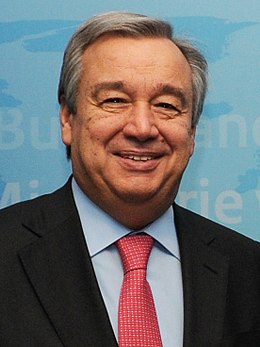
Message from the Secretary-General of the United Nations, Mr. António Manuel de Oliveira Guterres
Thirty years after the first World AIDS Day, the response to HIV stands at a crossroads. Which way we turn may define the course of the epidemic — whether we will end AIDS by 2030 or whether future generations will carry on bearing the burden of this devastating disease.
More than 77 million people have become infected with HIV and more than 35 million have died of an AIDS-related illness. Huge progress has been made in diagnosis and treatment, and prevention efforts have avoided millions of new infections.
Yet the pace of progress is not matching global ambition. New HIV infections are not falling rapidly enough. Some regions are lagging behind and financial resources are insufficient. Stigma and discrimination are still holding people back, especially key populations — including gay men and other men who have sex with men, sex workers, transgenders, people who inject drugs, prisoners and migrants and young women and adolescent girls. Moreover, one in four people living with HIV do not know that they have the virus, impeding them from making informed decisions on prevention, treatment and other care and support services.
There is still time to scale up testing for HIV; to enable more people to access treatment; to increase resources needed to prevent new infections; and to end the stigma. At this critical juncture, we need to take the right turn now.
WHAT IS PANCAP?
PANCAP is a Caribbean regional partnership of governments, regional civil society organisations, regional institutions and organisations, bilateral and multilateral agencies and contributing donor partners established on 14 February 2001. PANCAP provides a structured and unified approach to the Caribbean’s response to the HIV epidemic, and coordinates the response through the Caribbean Regional Strategic Framework on HIV and AIDS to maximise efficient use of resources and increase impact, mobilise resources and build the capacity of partners.
What are the Global AIDS Strategy 2021–2026 targets and commitments?
If targets and commitments in the strategy are achieved:
- The number of people who newly acquire HIV will decrease from 1.7 million in 2019 to less than 370 000 by 2025
- The number of people dying from AIDS-related illnesses will decrease from 690 000 in 2019 to less than 250 000 in 2025.
- The goal of eliminating new HIV infections among children will see the number of new HIV infections drop from 150,000 in 2019 to less than 22,000 in 2025.
What are the 95-95-95 Targets for ending AIDS?
- 95% of People Living with HIV know their HIV status;
- 95% of people who know their status on treatment; and
- 95% of people on treatment with suppressed viral loads.
HELPFUL LINKS:
Global AIDS Strategy 2021–2026, End Inequalities, End AIDS
https://pancap.org/pancap-documents/global-aids-strategy-2021-2026-end-inequalities-end-aids/
Caribbean Regional Strategic Framework on HIV and AIDS (CRSF) 2019-2025
https://pancap.org/pancap-documents/caribbean-regional-strategic-framework-2019-2025/
